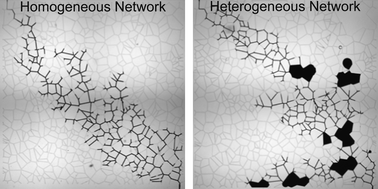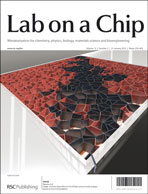Single- and two-phase flow in microfluidic porous media analogs based on Voronoi tessellation†
Abstract
The objective of this study was to create a microfluidic model of complex porous media for studying single and multiphase flows. Most experimental porous media models consist of periodic geometries that lend themselves to comparison with well-developed theoretical predictions. However, many real porous media such as geological formations and biological tissues contain a degree of randomness and complexity at certain length scales that is not adequately represented in periodic geometries. To design an experimental tool to study these complex geometries, we created microfluidic models of random homogeneous and heterogeneous networks based on Voronoi tessellations. These networks consisted of approximately 600 grains separated by a highly connected network of channels with an overall porosity of 0.11–0.20. We found that introducing heterogeneities in the form of large cavities within the network changed the permeability in a way that cannot be predicted by the classical porosity-permeability relationship known as the Kozeny equation. The values of permeability found in experiments were in excellent agreement with those calculated from three-dimensional lattice Boltzmann simulations. In two-phase flow experiments of oil displacement with


 Please wait while we load your content...
Please wait while we load your content...